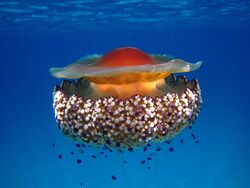Biology:Cotylorhiza
| Cotylorhiza | |
|---|---|

| |
| Cotylorhiza tuberculata | |
| Scientific classification | |
| Domain: | Eukaryota |
| Kingdom: | Animalia |
| Phylum: | Cnidaria |
| Class: | Scyphozoa |
| Order: | Rhizostomeae |
| Family: | Cepheidae |
| Genus: | Cotylorhiza Agassiz, 1862 |
| Species | |
| |
Cotylorhiza is a genus of true jellyfish from the family Cepheidae.[1] The genus is found in the central-east Atlantic, Mediterranean, and western Indian Ocean.
Description
The genus Cotylorhiza falls under the family Cepheidae, which includes jellyfish. Species in this genus include Cotylorhiza abulacrata, Cotylorhiza erythraea, and Cotylorhiza tuberculata, which is the most common species in the genus, as well as in the order Rhizostomeae. Characterized by eight short oral arms, this genus is pelagic and generally tinted white or yellow and include a sun shade at the top to protect arms and cnidoblasts.[2]
First discovered in the Sea of Marmara in the 1700s, the Cotylorhiza genus had major impacts on species in surrounding areas as it invaded the area.[3] Species reside in pelagic environments in southern European seas, where they impact ecological balances of ecosystem due to resource competitions and rapid reproduction patterns.[4] Cotylorhiza are among the most abundant jellyfish in the Mediterranean sea, though they are not native to this area.[5]
Lifestyle
Feeding
Organisms consume zooxanthellae and zooplankton through their eight moutharms, which transport consumed organisms to the stomach.[6] Juvenile individuals in the Cotylorhiza genus were found to have higher feeding rates than other jellyfish of the Cepheidae family, such as Rhizostoma pulmo.[7]
Reproduction and Life Cycle
Species begin as polyps attached to a substrate, and eventually grow into a medusa stage. The medusa are pelagic, swimming organisms in the jellyfish form.[2] In the medusa stage, sperm and egg cells release into the water and fertilize to form polyps on benthic substrates.[8] Jellyfish tend to be more abundant in spring seasons, as the temperature and resource concentrations are ideal for an increase in reproduction during this time.[9]
Relationships
Cnidarian abundance in the Northwest Mediterranean Sea can have major impacts on fish populations, as they pose a major predatory threat to juvenile fish.[10] The size and number of fish in this area was found to be directly correlated to the size and abundance of C. tuberculata.
Possible Human Impact
Jellyfish populations in the Mediterranean Sea, including those in the genus Cotylorhiza, may have hazardous effects on people in the area.[11] Species in this area are becoming progressively more venomous as more invasive predators enter the waters they inhabit, therefore hospitalizations and serious injury has increased in children swimming in these areas. Stings by Cotylorhiza tuberculata cause the following effects: pain in 100% of patients stung, a whip-like rash in 87.8% of patients, a small percentage of patients are hospitalized annually for fevers, chills, muscle spasms, and serious burns.[11]
Blooms of jellyfish may also impact economic stability in surrounding communities, due to overfishing which alters trophic processes.[12] As jellyfish overpopulate ecosystems, they may wipe out large numbers of fish in their habitat. Blooms occur because of changes in temperature and phytoplankton abundance in the ecosystem.[12]
References
- ↑ "Cotylorhiza". WoRMS. World Register of Marine Species. http://www.marinespecies.org/aphia.php?p=taxdetails&id=135255.
- ↑ 2.0 2.1 "Cotylorhiza tuberculata". https://www.sealifebase.ca/summary/Cotylorhiza-tuberculata.html.
- ↑ İşinibilir, Melek (2020-12-03). "First record of Cotylorhiza tuberculata (Macri, 1778) from the Sea of Marmara". Aquatic Sciences and Engineering: 38–41. doi:10.26650/ase2020804717. ISSN 2602-473X.
- ↑ Leoni, Valentina; Bonnet, Delphine; Ramírez‐Romero, Eduardo; Molinero, Juan Carlos (2021-01-15). "Biogeography and phenology of the jellyfish Rhizostoma pulmo (Cnidaria: Scyphozoa) in southern European seas". Global Ecology and Biogeography 30 (3): 622–639. doi:10.1111/geb.13241. ISSN 1466-822X. http://dx.doi.org/10.1111/geb.13241.
- ↑ Makar, A. B.; McMartin, K. E.; Palese, M.; Tephly, T. R. (June 1975). "Formate assay in body fluids: application in methanol poisoning". Biochemical Medicine 13 (2): 117–126. doi:10.1016/0006-2944(75)90147-7. ISSN 0006-2944. PMID 1. https://pubmed.ncbi.nlm.nih.gov/1.
- ↑ "Error: no
|title=specified when using {{Cite web}}". https://www.montereybayaquarium.org/animals/animals-a-to-z/mediterranean-jelly. - ↑ Mir-Arguimbau, Joan; Sabatés, Ana; Tilves, Uxue (May 2019). "Trophic ecology of Trachurus mediterraneus juveniles associated with the jellyfish Rhizostoma pulmo and Cotylorhiza tuberculata". Journal of Sea Research 147: 28–36. doi:10.1016/j.seares.2019.02.004. ISSN 1385-1101. Bibcode: 2019JSR...147...28M. http://dx.doi.org/10.1016/j.seares.2019.02.004.
- ↑ Killi, N.; Mariottini, G. L. (2018), "Cnidarian Jellyfish: Ecological Aspects, Nematocyst Isolation, and Treatment Methods of Sting", Results and Problems in Cell Differentiation (Cham: Springer International Publishing) 65: 477–513, doi:10.1007/978-3-319-92486-1_21, ISBN 978-3-319-92485-4, PMID 30083932, http://dx.doi.org/10.1007/978-3-319-92486-1_21, retrieved 2021-04-06
- ↑ Banha, Thomás N S; Morandini, André C; Rosário, Renan P; Martinelli Filho, José E (November 2020). "Scyphozoan jellyfish (Cnidaria, Medusozoa) from Amazon coast: distribution, temporal variation and length–weight relationship". Journal of Plankton Research 42 (6): 767–778. doi:10.1093/plankt/fbaa056. ISSN 0142-7873. http://dx.doi.org/10.1093/plankt/fbaa056.
- ↑ Tilves, Uxue; Sabatés, Ana; Blázquez, Mercedes; Raya, Vanesa; Fuentes, Verónica L. (2018-07-11). "Associations between fish and jellyfish in the NW Mediterranean". Marine Biology 165 (8). doi:10.1007/s00227-018-3381-4. ISSN 0025-3162. http://dx.doi.org/10.1007/s00227-018-3381-4.
- ↑ 11.0 11.1 Glatstein, Miguel; Adir, Dikla; Galil, Bella; Scolnik, Dennis; Rimon, Ayelet; Pivko-Levy, Dikla; Hoyte, Christopher (December 2018). "Pediatric jellyfish envenomation in the Mediterranean Sea". European Journal of Emergency Medicine 25 (6): 434–439. doi:10.1097/mej.0000000000000479. ISSN 0969-9546. PMID 28639958. http://dx.doi.org/10.1097/mej.0000000000000479.
- ↑ 12.0 12.1 Fernández-Alías, Alfredo; Marcos, Concepción; Quispe, Jhoni Ismael; Sabah, Sandra; Pérez-Ruzafa, Angel (September 2020). "Population dynamics and growth in three scyphozoan jellyfishes, and their relationship with environmental conditions in a coastal lagoon". Estuarine, Coastal and Shelf Science 243: 106901. doi:10.1016/j.ecss.2020.106901. ISSN 0272-7714. Bibcode: 2020ECSS..24306901F. http://dx.doi.org/10.1016/j.ecss.2020.106901.
Wikidata ☰ Q3381740 entry


